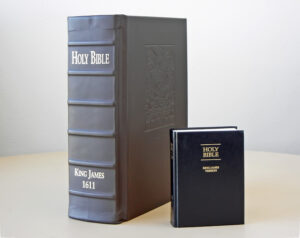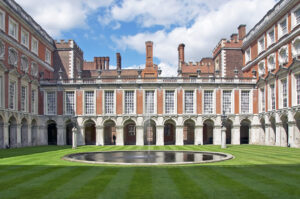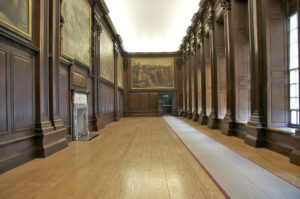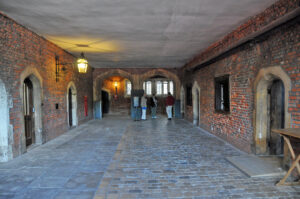Hampton Court Palace, Richmond, England

Hampton Court Palace in Richmond, Borough of London, is a significant historic site associated with the coming forth of the King James Bible. By extension, it is similarly significant to The Church of Jesus Christ of Latter-day Saints because of its role in the Restoration and its use presently by English speaking members of the Church. It was at Hampton Court that King James I of England called and held the Hampton Court Conference of January 1604. This was the king’s first year of his reign in England. Alister McGrath lists “October 24, 1603 as the day that James issued a proclamation stating that he had convened a conference to attended by himself, the Privy Council, and various ‘bishops and other learned men’ to deal with . . . issues at the palace of Hampton Court.” The conference was originally planned for November 1603 but was postponed until the following January because of an outbreak of the plague. One of the key issues to be dealt with was the rift between traditional practices of the Church of England and the wishes of the puritans who were seeking change in that church. Only four puritans attended the conference. Two of the four were John Rainolds (Reynolds) and Laurence Chaderton, who would soon be numbered among the translators.

King James Bible scholar, David Norton, notes: “On the second day of the Hampton Court conference, Monday 16 January, the leading spokesman for the puritans, John Rainolds apparently without warning, ‘moved his Majesty that there might be a new translation of the Bible, because those which were allowed in the reigns of Henry the eighth and Edward the sixth were corrupt and not answerable to the truth of the original.’” The best account of the conference is credited to William Barlow who would also serve as one of the translators of the KJB. The palace is located on the River Thames in the London Borough of Richmond, about twelve miles from central London. Half of the complex today has survived from the days of King Henry VIII. The rest was rebuilt by King William III.

In 1992, the First Presidency of The Church of Jesus Christ of Latter-day Saints issued the following: “While other Bible versions may be easier to read than the King James Version, in doctrinal matters latter-day revelation supports the King James Version in preference to other English translations. All of the Presidents of the Church, beginning with the Prophet Joseph Smith, have supported the King James Version by encouraging its continued use in the Church. In light of all the above, it is the English language Bible used by The Church of Jesus Christ of Latter-day Saints.” This directive and others similar to it, have served to maintain that important connection between the King James Bible and members of the Church.
Map and Directions
Ownership Status
Hampton Court Palace is a historic royal palace situated on the River Thames at Richmond, Borough of London. The site is about twelve miles from central London. The palace complex has set hours when one can visit and a fee is charged to view the interior and/or take a tour. For more information: https://www.hrp.org.uk/hampton-court-palace/#gs.pemcy8
Photos



Articles & Resources
Resources
Alister McGrath, In The Beginning: The Story of the King James Bible and How It Changed a Nation, a Language, and a Culture, 155-161.
David Norton, The King James Bible: A Short History From Tyndale to Today, 82-85.
Adam Nicolson, God’s Secretaries: The Making of the King James Bible, 42-61.
Judith Maltby and Helen Moore, in Helen Moore and Julian Reid, eds., Manifold Greatness: The Making of the King James Bible, 48-50.
